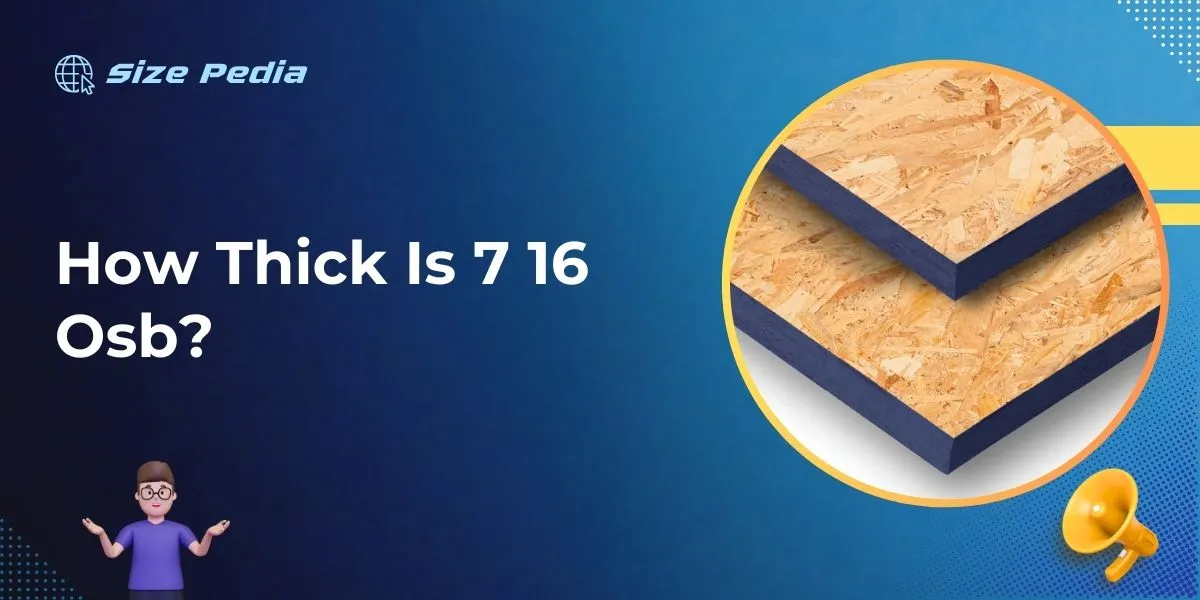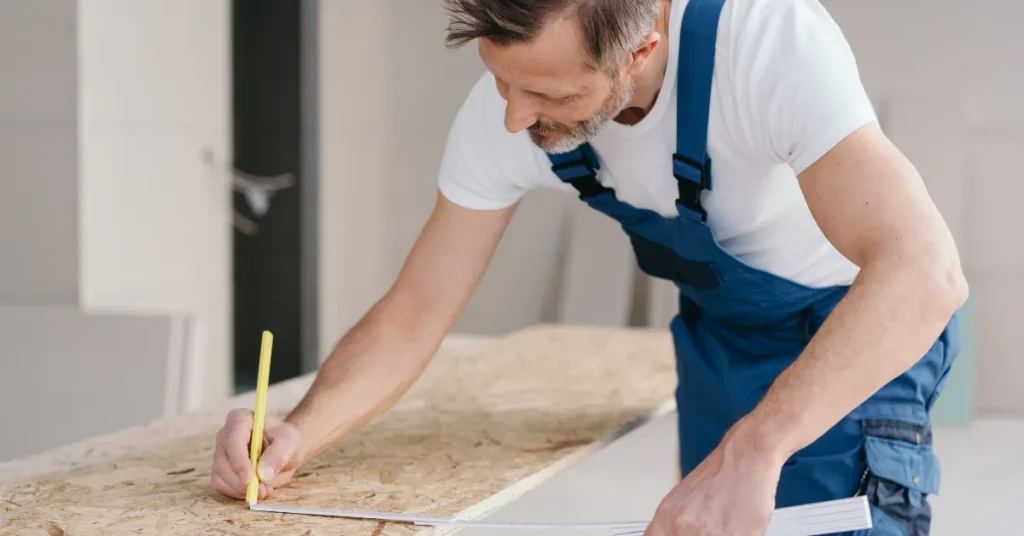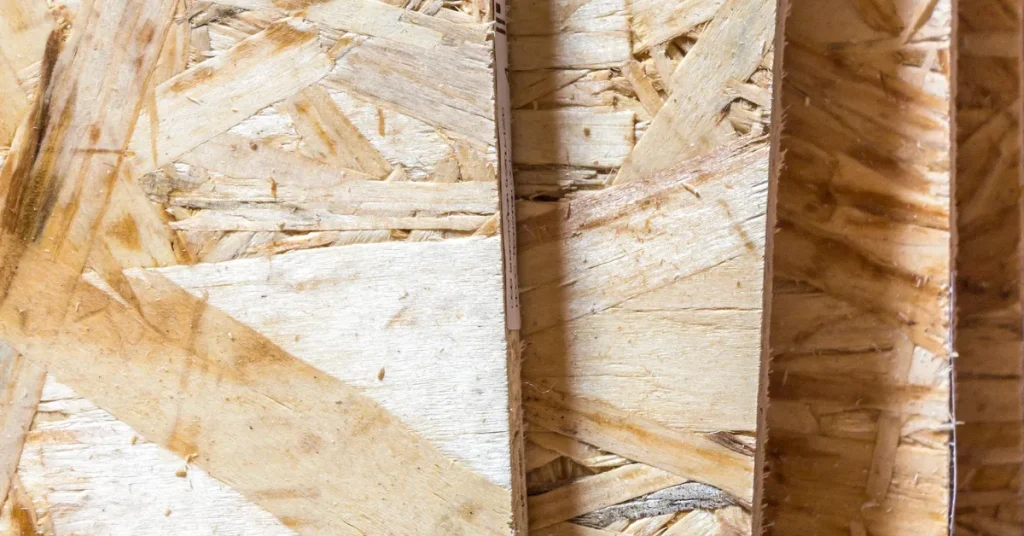7/16 OSB is approximately 0.4375 inches thick. This equates to just under half an inch in thickness.
Oriented Strand Board (OSB) is a versatile and durable engineered wood product used extensively in construction and building projects.
Crafted from compressed layers of wood strands bonded with adhesives, 7/16-inch OSB offers a resilient and cost-effective option for sheathing, roofing, and flooring.
Builders and DIY enthusiasts favor this thickness for its balance between rigidity and ease of handling. Its standardized sizing ensures consistent performance across various applications, making it a staple in residential and commercial construction.
Essential for structural integrity, 7/16 OSB delivers the strength required to meet rigorous building codes while providing a reliable base for finishes like siding, shingles, or flooring materials.

The Basics Of Osb
Oriented Strand Board (OSB) is a durable and versatile engineered wood panel. Builders, architects, and DIY enthusiasts rely on it. It easily withstands heavy loads and moisture.
Composition And Uses
OSB features wood strands bonded with waxes and resins. This structure creates a strong panel. It resists warping and breaking. OSB shines in various applications:
- Flooring – It provides a sturdy base for floors.
- Walls – Builders use it for imparting rigidity to structures.
- Roofing – OSB handles roof loads with ease.
- Furniture – Its smooth surface suits furniture making.
Comparing Thicknesses
Thickness varies with each OSB type. 7/16 inch OSB is common in residential use. Here’s how it stands against other sizes:
| Thickness | Usage |
| 1/4″ | Interior projects |
| 3/8″ | Lightweight uses |
| 7/16″ | Walls, roofing, subfloor |
| 1/2″ | Heavy-duty wall sheathing |
| 5/8″ | Roofing, subfloor for tiled areas |
| 3/4″ | Commercial floors, subfloors |
Measuring 7/16 Osb

Understanding the exact thickness of 7/16 OSB is crucial for construction projects. It ensures compatibility and structural integrity. This guide provides insights into measuring the standard thickness of 7/16 OSB and the tools required for accurate measurement.
Standard Thickness Explained
The label ‘7/16 OSB’ refers to Oriented Strand Board that is nominally 7/16 inch thick. In metric units, this is approximately 11.1mm. Despite this labeling, the actual thickness can vary due to manufacturing processes.
Factory standards allow a small margin of difference from the nominal size. This variance is typically within 1/32 inch.
| Label Size | Actual Thickness Range (inch) | Approximate Metric Equivalent (mm) |
| 7/16″ | 0.40625″ – 0.4375″ | 10.3 – 11.1 |
Tools For Accurate Measurement
To confirm the thickness of 7/16 OSB, precise tools are important. A reliable measuring tool is essential. Here is a list of tools that can give exact measurements:
- Caliper: Offers precise measurements to 0.01mm or 0.001 inch.
- Tape measure: Suitable for quick, rough estimates.
- Micrometer: Highly accurate tool, perfect for industrial use.
Using these tools, align them perpendicular to the edge of the OSB. Ensure a flush fit to avoid skewed results. Always double-check measurements for accuracy. Measuring the thickness before starting a project can save time and resources.
Strength And Durability Factors
7/16 inch OSB (Oriented Strand Board) stands out in building materials. It balances performance with cost-efficiency.
Builders often choose it for walls and roofing. This thickness supports everyday loads well. It’s about durability plus strength, vital for long-lasting structures.
Impact Of Thickness On Performance
The thickness of OSB impacts how it performs. Thicker boards can hold more weight. They resist sagging better. 7/16 inch OSB is a popular pick. It handles moderate loads. This makes it suitable for many construction tasks.
- Good load-bearing ability
- Resists bending and warping
- Supports insulation and drywall
Environmental Resistance
OSB’s ability to face weather is crucial. 7/16 inch OSB includes adhesives. These make it more resistant. It stands up to moisture better than thinner panels. It reduces the risk of swelling and decay. This robustness makes it a smart option for builders.
- Moisture-resistant materials
- Minimized swelling and distortion
- Long-lasting in varied climates
Applications Of 7/16 Osb
Applications of 7/16 OSB reveal the versatility of this woodworking marvel. The material’s thickness, precisely 7/16-inch, caters to various project needs. Let’s delve into where you can employ this robust and reliable board.
Construction Projects
7/16 OSB shines in the construction field due to its durability and strength. Builders frequently utilize it in the following ways:
- Sheathing in walls: Offers sturdiness and wind protection.
- Roofing support: Acts as a base layer beneath shingles.
- Floor underlayment: Provides a flat surface for flooring.
These applications demonstrate OSB’s critical role in structural integrity.
Diy And Home Improvement
Home enthusiasts find 7/16 OSB ideal for personal projects. It’s perfect for:
| Project Type | Use |
| Furniture Making | Crafting bookshelves and benches. |
| Decor | Creating wall panels and artworks. |
| Storage Solutions | Building sturdy shelves and cabinets. |
Personalize spaces with easy-to-work-with OSB.
Buying Guide For 7/16 Osb

When searching for the ideal oriented strand board (OSB) for a project, 7/16-inch OSB offers a blend of strength and affordability. It suits various applications, including roofing, flooring, and wall sheathing.
The following tips and cost considerations will guide you through selecting the best 7/16 OSB for your needs.
Tips For Selecting High-quality Osb
Check the surface: Look for a smooth finish with no irregularities.
Review the edges: Edges should be straight and intact for a snug fit.
Inspect for damage: Avoid panels with chips or extensive damage.
Assess the adhesive: Ensure the adhesive used is weather-resistant.
Look for certification: Panels should meet APA or similar standards.
Cost Considerations
The price of 7/16 OSB can vary based on factors such as:
- Brand reputation: Popular brands might cost more.
- Quantity: Buying in bulk often saves money.
- Location: Prices vary from store to store.
- Season: Costs can fluctuate with demand.
- Thickness: Thicker OSB generally costs more.
Compare prices: Visit multiple suppliers for the best deals.
Watch for sales: Discounts can occur during off-season times.
Consider alternatives: Sometimes, different thicknesses can offer similar performance for less cost.
FAQs About How Thick Is 7 16 Osb
What Is The Actual Thickness Of Osb?
OSB typically ranges in thickness from 1/4 inch (6mm) to 3/4 inch (19mm). Common sizes include 7/16-inch, 1/2-inch, 5/8-inch, and 3/4-inch.
Can You Use 7 16 Osb For Roof Sheathing?
Yes, you can use 7/16 inch OSB for roof sheathing. It is important to follow local building codes and manufacturer recommendations for installation.
Is 7 16 Osb Good For Exterior Walls?
Yes, 7/16 OSB is suitable for exterior walls as sheathing material when combined with proper water-resistant barriers and adhering to local building codes.
What Is The Span Rating Of 7 16 Osb?
The span rating for 7/16 inch OSB typically ranges between 16 to 24 inches on center for roof sheathing applications.
Conclusion
Summing up, 7/16-inch OSB is a versatile choice for many construction projects. Its specific thickness balances durability with ease of handling. Whether you’re tackling a subfloor or sheathing a roof, this material provides reliable performance.
For builders and DIY enthusiasts alike, 7/16-inch OSB stands as an essential component in creating strong, dependable structures.
Resources:
1. https://basc.pnnl.gov/resource-guides/structural-sheathing-plywoodosb-exterior-walls
